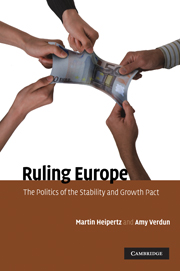1 - The politics of the Stability and Growth Pact
Published online by Cambridge University Press: 06 July 2010
Summary
On 25 November 2003, the Economics and Financial Affairs Council (ECOFIN) effectively decided to suspend the Stability and Growth Pact (SGP). What had seemed a set of ‘boring’, or at least technical, European Union (EU) regulations on budgetary policy coordination and surveillance, suddenly made headline news. It did not grab the attention of the world because of ‘successful’ European integration, but rather, in the eyes of the press, it marked the end of an era of rapid progress in European economic and monetary integration. France and Germany, the two countries that had been the founders of the SGP, were now the ones seen to dismantle it when confronted with procedural steps that – eventually – could have led to sanctions for their persistent failure to respect the deficit limit. Concerned with that prospect, they lobbied enough Member States so that the required qualified majority, needed to adopt the Commission recommendation to take the procedure one step further, could not be reached. According to many commentators, this decision was by no means in line with the spirit of the Pact and it flew in the face of all those who had been led to believe that the underlying intention of the framework was to enshrine budgetary discipline by automatically imposing fines on delinquents.
Some observers, however, were pleased to see the arrangement abandoned. They argued that Europe's single currency would be fine without it.
- Type
- Chapter
- Information
- Ruling EuropeThe Politics of the Stability and Growth Pact, pp. 1 - 16Publisher: Cambridge University PressPrint publication year: 2010



